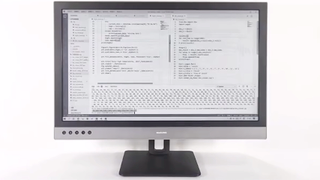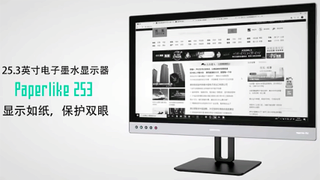16 Shades of Gray: 25-inch E Ink Monitor Could Ease Eyestrain
Dasung's Paperlike 253 offers large size and high resolution.

Traditionally, E Ink displays have been used almost exclusively for ebook readers and occasionally for devices that do not need a color screen, but which could benefit greatly from low power consumption and good contrast. But there is a company called Dasung that uses E Ink for larger displays aimed at other applications. Its biggest monitor to date is the 25-inch Paperlike 253, which is expected to hit the market in 2021.
Dasung positions its E Ink products specifically for those who experience eye pain when working with traditional LCD or OLED monitors because of blue light, bright colors, or screen flash. In particular, these electronic paper displays can be used by children with developing eyes, various office workers who spend a lot of time staring at their monitors, and the elderly. So far, Dasung has designed a 7.8-inch tablet with an E Ink display as well as a 13.3-inch E Ink external monitor for laptops. To address a broader audience who want to use E Ink instead of a regular screen, Dasung has developed its 25.3-inch Paperlike monitor.
The Dasung Paperlike 253 boasts a 3200x1800 resolution yet can only display 16 shades of gray. It also has a slower refresh rate when compared to typical LCD or OLED monitors. Meanwhile, the Paperlike 253 does not use any kind of backlighting and its brightness can be increased by a table lamp if needed. Evidently, the Dasung Paperlike 253 was not designed for anything with even decent refresh rates so don't expect to find it on our best gaming monitors list anytime soon. However, if all one needs is to read and write text or code, this display will suffice, notes Liliputing.

Dasung recently demonstrated a prototype of its Paperlike 253 to its potential customers from China without revealing any actual launch date or price. Given that the company is not trying to collect money on development and production start on a crowdfunding platform, it looks like the product is ready, but still needs some polishing off before it can go to the market. To that end, it is reasonable to expect it to be available in 2021.
Dasung's products were once available at Amazon, but at present those who want to get a 13.3-inch E Ink display will have to pay the company directly, so it is unclear whether Dasung has any plans to bring its Paperlike 253 to markets outside of China.
Pricing of the Paperlike is not something that the company wants to talk about just yet. Dasung has only revealed that the product will cost "¥1xxx9", which means anything from ¥10009 to ¥19999 (and it is unknown whether this includes taxes and/or shipping). Based on the current exchange rates, this 'teaser price' translates to anything between $1500 and $3000. Keeping in mind that the company sells its 13.3-inchers for about $1000, a rather high price for the new product is not something completely unexpected.
Stay on the Cutting Edge
Join the experts who read Tom's Hardware for the inside track on enthusiast PC tech news — and have for over 25 years. We'll send breaking news and in-depth reviews of CPUs, GPUs, AI, maker hardware and more straight to your inbox.

Anton Shilov is a Freelance News Writer at Tom’s Hardware US. Over the past couple of decades, he has covered everything from CPUs and GPUs to supercomputers and from modern process technologies and latest fab tools to high-tech industry trends.
-
voyteck For most (!) people it's all about background lighting anyway. If luminosity (and preferably colour) of the wall behind your display matches the screen you should be fine. The advantage of e-ink is mostly practical: it doesn't stand out too much against the background. Of course, it's also about resolution, weight, uniformity, power consumption and general feeling but the eye strain in most cases comes from that difference between screen and background.Reply -
deesider Reply
I completely agree with this. For me I have found that in most setups it helps to turn the screen brightness all the way down, close to minimum.voyteck said:For most (!) people it's all about background lighting anyway. If luminosity (and preferably colour) of the wall behind your display matches the screen you should be fine. The advantage of e-ink is mostly practical: it doesn't stand out too much against the background. Of course, it's also about resolution, weight, uniformity, power consumption and general feeling but the eye strain in most cases comes from that difference between screen and background. -
voyteck Replydeesider said:I completely agree with this. For me I have found that in most setups it helps to turn the screen brightness all the way down, close to minimum.
Well, as long as the wall behind the screen is lit adequately, I prefer moderately high level of brightness. This contrast is all that really matters. For example, a book read in a shadow in a sunny day is very, very bright and I don't think anyone would say that reading in such conditions causes eye-strain. -
cryoburner Reply
Yeah, placing a light source like a lamp behind one's monitor, with its light projecting onto the wall, is likely to help a lot with eyestrain. And in a dimly-lit room, light projected onto the wall and ceiling behind a monitor can produce a nice diffuse lighting for the room without harsh shadows, and screen reflections tend to be minimized when their are no light sources behind the viewer.voyteck said:For most (!) people it's all about background lighting anyway. If luminosity (and preferably colour) of the wall behind your display matches the screen you should be fine. The advantage of e-ink is mostly practical: it doesn't stand out too much against the background. Of course, it's also about resolution, weight, uniformity, power consumption and general feeling but the eye strain in most cases comes from that difference between screen and background.
As for the other potential advantages of e-ink, they don't really provide much benefit in a desktop environment. Resolution-wise, at 3200x1800 we're only talking about a resolution roughly in-between 1440p and 4K. A 4K panel will not only offer 44% higher resolution, but that also works to higher pixel density on anything up to a 30" screen. And considering such screens can be found starting at around $300 or so, that makes spending thousands for an e-ink panel a bit of a tough sell. Especially if one intends to use such a screen for anything other than strictly text-viewing, as it's only grayscale, and just 16 levels of gray at that. Plus, the response-times of e-ink are quite poor, with significant ghosting on these panels, and a refresh rate that's probably not much higher than 10-15Hz judging by their video. Any power or weight advantages also won't be all that useful on the desktop. E-Ink could be an interesting alternative to other display technologies for monitors, but without significantly better pricing, it's going to be extremely niche.
Most Popular






